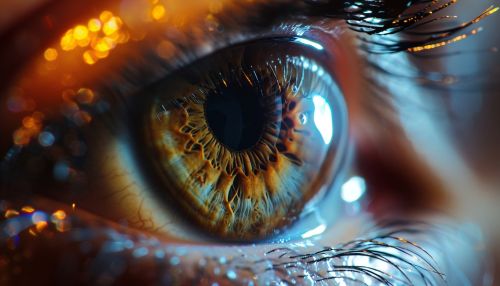Iris recognition: Difference between revisions
(Created page with "== Introduction == Iris recognition is a biometric identification method that uses pattern-recognition techniques based on high-resolution images of the irises of an individual's eyes. The iris is the colored ring around the pupil of the eye, and its complex patterns are unique to each individual, making it an ideal characteristic for biometric identification. == History and Development == The concept of using the iris for identification purposes dates back to the lat...") |
No edit summary |
||
| (One intermediate revision by the same user not shown) | |||
| Line 17: | Line 17: | ||
The first step in iris recognition is capturing a high-resolution image of the iris. This is typically done using a specialized camera system that can operate in the infrared spectrum to reduce reflections and enhance the visibility of the iris patterns. | The first step in iris recognition is capturing a high-resolution image of the iris. This is typically done using a specialized camera system that can operate in the infrared spectrum to reduce reflections and enhance the visibility of the iris patterns. | ||
[[Image:Detail-79669.jpg|thumb|center|Close-up image of an eye undergoing an iris scan.|class=only_on_mobile]] | |||
[[Image:Detail-79670.jpg|thumb|center|Close-up image of an eye undergoing an iris scan.|class=only_on_desktop]] | |||
=== Preprocessing === | === Preprocessing === | ||
Latest revision as of 14:55, 19 May 2024
Introduction
Iris recognition is a biometric identification method that uses pattern-recognition techniques based on high-resolution images of the irises of an individual's eyes. The iris is the colored ring around the pupil of the eye, and its complex patterns are unique to each individual, making it an ideal characteristic for biometric identification.
History and Development
The concept of using the iris for identification purposes dates back to the late 19th century. However, it was not until the 1980s that modern iris recognition technology began to take shape. The pioneering work of Dr. John Daugman in the early 1990s laid the foundation for contemporary iris recognition systems. Daugman's algorithms for iris recognition are widely regarded as the most effective and are still in use today.
Anatomy of the Iris
The iris is a thin, circular structure in the eye, responsible for controlling the diameter and size of the pupil and thus the amount of light reaching the retina. It is composed of two layers: the pigmented epithelial layer and the stromal layer. The stromal layer contains blood vessels, melanocytes, and connective tissue, contributing to the unique patterns observed in each individual's iris.
Iris Recognition Process
Image Acquisition
The first step in iris recognition is capturing a high-resolution image of the iris. This is typically done using a specialized camera system that can operate in the infrared spectrum to reduce reflections and enhance the visibility of the iris patterns.


Preprocessing
Once the image is captured, it undergoes preprocessing to isolate the iris from other parts of the eye. This involves detecting the boundaries of the iris and the pupil, as well as removing any occlusions such as eyelashes or reflections.
Feature Extraction
The next step is feature extraction, where the unique patterns of the iris are converted into a mathematical representation. This is typically done using algorithms that analyze the texture, furrows, and crypts of the iris to create a distinctive iris code.
Matching
The final step is matching, where the extracted features are compared against a database of stored iris codes to find a match. This involves calculating the Hamming distance between the iris codes, with a lower distance indicating a higher likelihood of a match.
Applications
Iris recognition is used in various applications due to its high accuracy and reliability. Some of the most common applications include:
- **Security and Access Control:** Iris recognition is widely used in secure facilities to control access and ensure that only authorized personnel can enter.
- **Border Control:** Many countries use iris recognition at border checkpoints to verify the identity of travelers and prevent illegal entry.
- **Healthcare:** Iris recognition is used in hospitals and clinics to ensure patient identification and prevent medical errors.
- **Banking and Finance:** Some financial institutions use iris recognition for secure transactions and to prevent fraud.
Advantages and Limitations
Advantages
- **High Accuracy:** Iris recognition has a very low false acceptance rate (FAR) and false rejection rate (FRR), making it one of the most accurate biometric methods.
- **Non-Invasive:** Unlike fingerprint or DNA analysis, iris recognition does not require physical contact, making it more hygienic and less intrusive.
- **Unique Patterns:** The patterns in the iris are highly unique and stable over a person's lifetime, making it a reliable method for long-term identification.
Limitations
- **Cost:** The high cost of specialized cameras and software can be a barrier to widespread adoption.
- **Environmental Factors:** Factors such as lighting conditions, reflections, and occlusions can affect the accuracy of iris recognition.
- **User Cooperation:** Successful iris recognition requires the subject to remain still and look directly at the camera, which may not always be feasible.
Ethical and Privacy Considerations
As with any biometric technology, iris recognition raises ethical and privacy concerns. The collection and storage of biometric data can be seen as an invasion of privacy, and there is always the risk of data breaches. It is essential to implement robust security measures and ensure that the use of iris recognition complies with legal and ethical standards.
Future Trends
The future of iris recognition looks promising, with ongoing research and development aimed at improving accuracy, reducing costs, and expanding applications. Advances in artificial intelligence and machine learning are expected to enhance the capabilities of iris recognition systems, making them more robust and versatile.
See Also
- Biometrics
- Facial Recognition
- Fingerprint Recognition
- Retina Scan
- Artificial Intelligence in Biometrics
